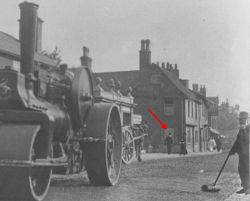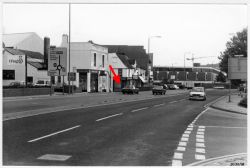
Oxford Road c1900
Lewis Broughton was born in 1842, the son of William Broughton, a stone mason living and working in Oxford Road, High Wycombe. Lewis continued the family trade on the same site, building a large and successful business as a Stone and Monumental Mason in the town - indeed, a mark of his success was the widespread appearance of his name in the press when he was responsible for overseeing the preparations for the burial of Benjamin Disraeli at Hughenden in 1881.
Lewis Broughton was not a professional photographer - the surviving albums acquired by the SWOP project show all the usual mistakes of the keen amateur - but it is his choice of subject/technique that is of value, giving us a unique view of Wycombe folk in the late 1890's. With the exception of some 30 or so 'holiday snaps', all his subjects were unaware that their photo was being taken, using a concealed camera in his house.


The window through which the photos were taken is shown by the arrows, both as it would have been in the late 1890's, and the same site (then Heritage's) just before demolition in 1991. Now (2016) it is replaced by the main entrance to Sainsburys.
Young women/girls were the predominant target of Lewis Broughton's hidden camera, exhibiting the fashion of the day as they head for church or chapel. The photographs are taken over a number of years, and fill two albums. Whilst some of the people are named, the majority are not. Maybe you can help identify them?
Lewis Broughton was a founder member of the High Wycombe and District Amateur Photographic Society in 1892, and was President from about 1893 to 1896. It was under his Presidency in 1894 that the society was renamed as the Wycombe Camera Club. At his death, he was described as "a clever exponent of the wet-plate system". It remains a mystery as to why he took so many photos of the people of Wycombe, and over such a number of years. There is just one report in the local press that in 1899 he "Exhibited a collection of 'snap shots' at the White Hart St Primitive Methodist Mutual Improvement Class".
In 1902 he sold his Oxford Road business, intending to retire away from the town, but shortly after, he became paralysed (a stroke?) and remained an invalid, living in Crown Lane, until his death in 1918. He was twice-married, but Edwin, his only son, died in South Africa in 1893.